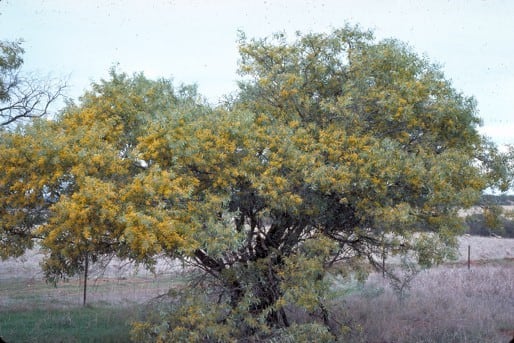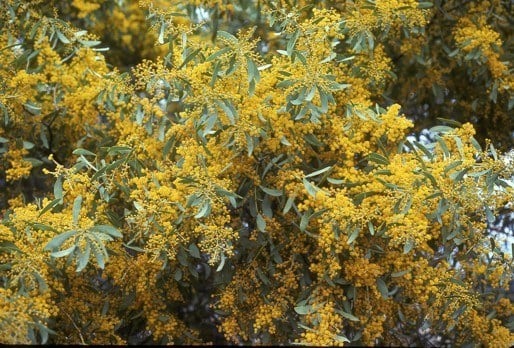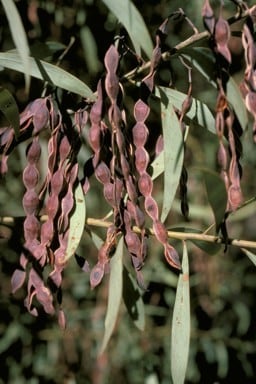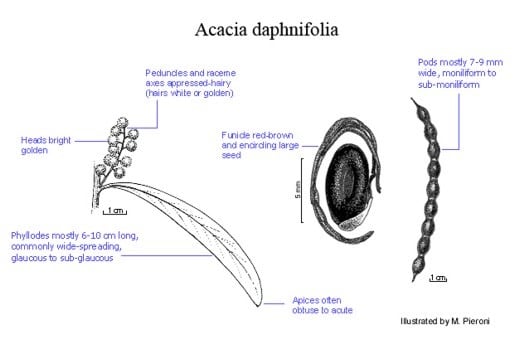Acacia daphnifolia Meisn.
WATTLE
Acacias of Australia
Common Name
Northern Manna Wattle
Family
Fabaceae
Distribution
Occurs in the northern wheatbelt region of south-western W.A. from Cataby Brook (c. 40 km E Moora), near Watheroo and the Manmanning–Bencubbin area N through Mullewa to the Murchison R. near Ajana (c. 100 km N of Geraldton).
Description
Shrub or tree 2.5–4 m high, normally multistemmed, often clonal by root-suckering. Bark light grey, mostly smooth. Branchlets glabrous. Phyllodes normally patent, sometimes sub-pendulous, oblanceolate to narrowly elliptic or sometimes narrowly oblong-elliptic, straight to shallowly recurved, (4–) 6–10 cm long, (4–) 6–15 (–27) mm wide, broadest phyllodes are on sucker regrowth, obtuse to acuminate, thinly coriaceous, glaucous to subglaucous or dull green, glabrous, 1-nerved per face, finely penninerved; gland not prominent, (4–) 7–20 (–27) mm above pulvinus. Inflorescences racemose; raceme axes 1.5–5 cm long, densely appressed-puberulous with light golden or silvery white hairs that are often sparse or absent at base of axes; peduncles 2–4 mm long, to 6 (–7) mm in fruit, indumentum as on raceme axes; heads globular, 3–4 mm diam. (dry), 17–30-flowered, golden, showy, delicately fragrant; bracteole laminae fimbriolate. Flowers 5-merous, sepals united. Pods moniliform to submoniliform, 8–20 cm long, 7–9 (–10) mm wide, thinly coriaceous, dark brown to blackish (dry), glabrous. Seeds longitudinal, oblong to elliptic, 7–9 mm long, 5–5.5 mm wide, dull or slightly shiny, minutely verruculose, dark brown to back, ½ to wholly encircled by creamy white (fresh) or light- to mid-brown (dry), slender funicle; aril clavate.
Phenology
Flowers late April–mid-July.
Habitat
Grows in flat or low-undulating country where it often occurs in lower parts of the landscape in water-gaining sites. Commonly grows in association with granite and favours sandy loam or clay-loam soils. It often occurs on degraded road verges where it commonly forms localized clonal clumps.
Specimens
W.A.: c. 4 miles [6.4 km] W of Mullewa, A.M.Ashby 4640 (CANB, K, NY, PERTH); Ajana, D.Bellairs 1621 (PERTH); Cataby Brook, Brand Hwy, B.R.Maslin 6033 (PERTH); 23.5 km NE of Wubin on Great Northern Hwy (just E of Rabbit Proof Fence Rd), B.R. Maslin 8190H-J (all PERTH); 8 km E of Lynton Stn on Northampton to Port Gregory rd, R.A.Saffrey 1522 (CANB, K, MEL, PERTH).
Notes
Acacia daphnifolia is a member of the ‘Acacia microbotrya group’ closely related to the more southerly distributed A. microbotyrya which differs most obviously in its taller stature, pale-coloured heads and generally longer phyllodes that are often less glaucous and have a greater propensity to droop; the distributions of the two species overlap in the area from near Moora E to through Wongan Hills to near Bencubbin and here it can be difficult assigning specimens to one species or the other. Also close to the more northerly distributed A. amblyophylla which is distinguished by its broader pods and a combination of its oblanceolate, obtuse, green, rather narrow phyllodes, and by its more aggressively suckering habit. Also related to A. splendens.
Phyllodes are very variable as to size, curvature and the shape of their apices. It appears that juvenile phyllodes are relatively short (about 4–6 cm long), often oblanceolate, ±straight and obtuse to sub-acute; adult phyllodes are longer (about 7–10 cm), ±narrowly elliptic, shallowly recurved and acute to acuminate. Both these phyllode forms (and many intermediates between them) have been observed in biologically mature plants, some of which are presumably neotenous.
This species was treated as conspecific with A. microbotrya by B.R.Maslin, Fl. Australia 11A: 284 (2001), but unpublished studies by that author indicate it is appropriate to be treated as a distinct species.
FOA Reference
Data derived from Flora of Australia Volumes 11A (2001), 11B (2001) and 12 (1998), products of ABRS, ©Commonwealth of Australia
Author
B.R.Maslin
This identification key and fact sheets are available as a mobile application:
URL: https://apps.lucidcentral.org/wattle/
© Copyright 2018. All rights reserved.


















